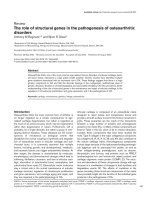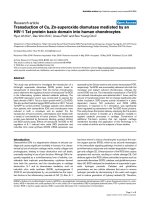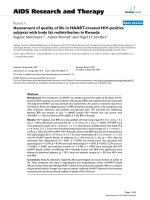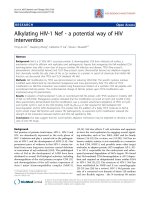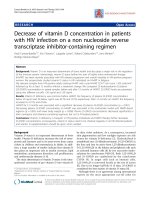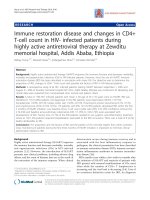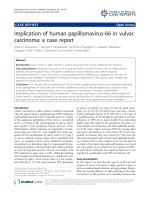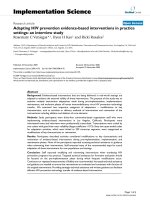Báo cáo y học: "Adapting HIV prevention evidence-based interventions in practice settings: an interview study" potx
Bạn đang xem bản rút gọn của tài liệu. Xem và tải ngay bản đầy đủ của tài liệu tại đây (225.32 KB, 9 trang )
BioMed Central
Page 1 of 9
(page number not for citation purposes)
Implementation Science
Open Access
Research article
Adapting HIV prevention evidence-based interventions in practice
settings: an interview study
Rosemary C Veniegas*
1
, Uyen H Kao
1
and Ricki Rosales
2
Address:
1
UCLA Department of Family Medicine and Center for HIV Identification, Prevention and Treatment Services, Los Angeles, CA, USA and
2
City of Los Angeles AIDS Coordinator's Office, Los Angeles, CA, USA
Email: Rosemary C Veniegas* - ; Uyen H Kao - ; Ricki Rosales -
* Corresponding author
Abstract
Background: Evidence-based interventions that are being delivered in real-world settings are
adapted to enhance the external validity of these interventions. The purpose of this study was to
examine multiple intervention adaptations made during pre-implementation, implementation,
maintenance, and evolution phases of human immunodeficiency virus HIV prevention technology
transfer. We examined two important categories of adaptations modifications to key
characteristics, such as activities or delivery methods of interventions and reinvention of the
interventions including addition and deletion of core elements.
Methods: Study participants were thirty-four community-based organization staff who were
implementing evidence-based interventions in Los Angeles, California. Participants were
interviewed twice and interviews were professionally transcribed. Transcriptions were coded by
two coders with good inter-rater reliability (kappa coefficient = 0.73). Sixty-two open-ended codes
for adaptation activities, which were linked to 229 transcript segments, were categorized as
modifications of key characteristics or reinvention.
Results: Participants described activities considered modifications to key characteristics and
reinvention of evidence-based interventions during pre-implementation, implementation, and
maintenance phases. None of the participants reported accessing technical assistance or guidance
when reinventing their interventions. Staff executed many of the recommended steps for sound
adaptation of these interventions for new populations and settings.
Conclusion: Staff reported modifying and reinventing interventions when translating HIV
prevention programs into practice. Targeted technical assistance for formative evaluation should
be focused on the pre-implementation phase during which frequent modifications occur.
Continuous or repeated measurements of fidelity are recommended. Increased technical assistance
and guidance are needed to ensure that reinventions are evaluated and consistent with the aims of
the original interventions. Providing strategic technical assistance and written guidance can facilitate
effective HIV prevention technology transfer of evidence-based interventions.
Published: 23 November 2009
Implementation Science 2009, 4:76 doi:10.1186/1748-5908-4-76
Received: 30 December 2008
Accepted: 23 November 2009
This article is available from: />© 2009 Veniegas et al; licensee BioMed Central Ltd.
This is an Open Access article distributed under the terms of the Creative Commons Attribution License ( />),
which permits unrestricted use, distribution, and reproduction in any medium, provided the original work is properly cited.
Implementation Science 2009, 4:76 />Page 2 of 9
(page number not for citation purposes)
Background
Balancing implementation fidelity with ensuring the
deliverability and relevance of an intervention to a target
population is an important task in the technology transfer
of evidence-based programs and practices into 'real-world'
settings [1-3]. The United States Centers for Disease Con-
trol and Prevention (CDC) recommends adapting human
immunodeficiency virus HIV prevention evidence-based
interventions' key characteristics modifying activities or
delivery methods that do not conflict with the core ele-
ments or behavioural theory for the intervention to bet-
ter suit organizational or participants' needs. Core
elements of these interventions, which are the compo-
nents considered responsible for their effectiveness, are
not to be modified or deleted. Changes to core elements
are considered reinvention [4]. To date, the CDC has iden-
tified 69 evidence-based HIV prevention interventions
[5].
Adherence to intervention core elements is strongly rec-
ommended to ensure effective reduction of HIV-related
risk behaviours [6,7]. However, the CDC has also recog-
nized that total adherence is a idealized goal in many set-
tings where these interventions are being used with new
target populations [4,8,9]. Knowing when community-
based organizations make changes and what changes they
make will inform efforts to provide timely guidance and
technical assistance regarding what kinds of modifica-
tions challenge fidelity to the core elements and behav-
iour change theories of the original interventions. Three
versions of HIV prevention intervention guidance were
released by the CDC to aid agencies that are implement-
ing evidence-based interventions with planning and exe-
cuting these interventions [4,8,9]. All versions of the
guidance describe the core elements and key characteris-
tics of specific evidence-based interventions that were rec-
ommended by the CDC. They also describe adaptation
steps, resource requirements, recruitment, policies and
standards, quality assurance, and monitoring and evalua-
tion for such interventions.
Modifications to evidence-based interventions in practice
Among the most widely-used interventions disseminated
by the CDC are the interventions Mpowerment and Sisters
Informing Sisters About Topics on AIDS (SISTA). Mpow-
erment has been adapted by at least 75 and up to 150
community-based organizations in the U.S. [10]. The nine
core elements of Mpowerment are: recruiting and main-
taining a core group of 12 to 20 young gay and bisexual
men to design and carry out project activities; recruiting
volunteers to help deliver services and to make important
decisions about the program; using project coordinators
to oversee project activities; establishing a dedicated
project space where many of the project activities can be
held; conducting formal outreach, including educational
activities and social events; conducting informal outreach
to influence behaviour change; convening peer-led, one-
time discussion groups (M-groups); conducting a public-
ity campaign about the project within the community;
and convening a community advisory board. Reported
adaptations made to Mpowerment across the U.S.
included significant changes to core elements and key
characteristics to suit the implementers' or local needs
[10,11]. From 28% to 75% of community-based organi-
zations (CBOs) delivered the intervention to different eth-
nic groups, age groups, and settings than were specified by
the developers. CDC guidance allows for modifications to
the activities for coordinators, volunteers, core group
members, informal and formal outreach, M-groups, pub-
licity campaign, and community advisory board.
The seven core elements of SISTA are: conducting small-
group sessions on session objectives to address the chal-
lenges and joys of being an African American woman
using modelling and role plays to promote skills develop-
ment and acquisition; using a skilled facilitator to lead
small-group sessions; using culture- and gender-appropri-
ate materials promoting pride and self-worth among Afri-
can American women; teaching women sexual assertion
skills for use with partners and in sexual negotiations;
teaching women condom-use skills, positive attitudes,
and norms toward consistent condom use, and knowl-
edge of how to put condoms on their partners; discussing
the cultural- and gender-related issues that serve as barri-
ers when negotiating safer sex; and, emphasizing their
partner's involvement in practicing safer sex [8]. Staff
from at least 334 agencies in the U.S. have been trained in
SISTA [12]. Recently-released guidance on this interven-
tion describes how to carefully adapt SISTA to the cultural-
and gender-related needs of Latinas [13]. CDC guidance
allows for modification of the duration of the sessions,
setting for delivery, and addition of other discussion top-
ics relevant to African American women.
Recommended adaptation pre-implementation and
implementation steps
To aid community-based organizations in adapting and
implementing such interventions as Mpowerment and
SISTA, the CDC guidance states that agencies that are
planning to adapt interventions must first conduct form-
ative evaluation to define the target population, culture,
behaviours, and risk factors that put the target population
at risk for HIV [8]. Agencies are encouraged to develop an
intervention implementation plan, provide ongoing lead-
ership to the intervention from within the agency, solicit
staff feedback and suggestions for addressing delivery
problems encountered, provide additional training to
staff to be able to deliver the intervention, ensure fidelity
to core elements, and monitor client responsiveness to the
interventions as part of quality assurance. In practice,
Implementation Science 2009, 4:76 />Page 3 of 9
(page number not for citation purposes)
agencies that are using CDC-recommended interventions
vary in the extent to which they conduct these pre-imple-
mentation and implementation steps [14,15]. Compiling
a clear picture of changes made during intervention pre-
implementation through maintenance phases can inform
the development of future guidance for agencies and can
illuminate reasons for increased or decreased intervention
effectiveness in preventing HIV.
Technical assistance and guidance for adaptation
Agencies that were directly funded by the CDC for HIV
prevention between 2004 and 2009 were able to publicly
access written guidance for adaptation, and contact up to
18 organizations that were funded to provide guidance on
adapting, implementing, and evaluating interventions
[16-18]. At the time that this study was conducted, few of
the agencies that were directly or indirectly funded in Los
Angeles, California were aware of such available resources
[19]. The forms of CDC guidance were released after the
Los Angeles agencies had been funded and initiated their
adapted interventions.
Methods
Design
Key informant interviews were conducted with publicly
identified staff who were implementing evidence-based
HIV prevention interventions. Potential participants were
recruited from publicly available lists of staff at HIV/AIDS
prevention service organizations that were implementing
HIV prevention interventions, and via recruitment letters
and e-mails that were sent to publicly available lists for
HIV/AIDS service organizations in Los Angeles County.
The first two authors, who provide ongoing technical
assistance on HIV prevention and evidence-based inter-
ventions to organizations in Los Angeles County, com-
piled a list of potential participants based on responses to
the recruitment postings and on their knowledge of inter-
ventions being conducted in the region. The UCLA Insti-
tutional Review Board provided oversight of all activities
and to ensure compliance with the Helsinki Declaration
(Study ID G05-03-025-11).
Setting and Participants
Participant eligibility criteria were: being employed by an
organization that provided HIV prevention services in Los
Angeles County; being involved in the review, selection,
implementation, or evaluation of evidence-based HIV
prevention interventions at their organization; and being
willing to participate in two recorded in-person interviews
and a brief survey. Receipt of CDC funding was not an eli-
gibility criteria for this study. There were 41 individuals
who were contacted for participation. Potential partici-
pants were informed about the aims of the study to under-
stand the use of evidence-based interventions for HIV
prevention and to develop technical assistance resources
for such interventions in Los Angeles County, California.
Of the 41 who were contacted, 34 agreed to participate,
three declined participation, and the remaining four were
ineligible. Of the three individuals who declined partici-
pation two declined because they did not consider them-
selves to be the appropriate person for the interviews and
one person was not interested in participating. These 34
staff worked at 22 distinct organizations. Twenty-one par-
ticipants were female, 10 were male, and three were trans-
gender male-to-female. Eighteen participants were Latino/
Hispanic, four were African American, four were Cauca-
sian, one was Asian/Pacific Islander, and seven reported
having multiple ethnicities. Ten participants were at agen-
cies that were implementing multiple evidence-based
interventions. Fourteen participants had ten or more years
of HIV prevention experience, nine had five to ten years of
experience, four had three to five years of experience, one
had one to three years of experience, and six had six to
eleven months of experience. Six participants had either
changed positions or had left their original organization
by the end of the study. Only one participant did not com-
plete the second interview. Participants were asked to
identify the evidence-based intervention on which they
spent the most time. Nine participants mentioned the
Mpowerment intervention, five participants mentioned
SISTA, three participants mentioned Popular Opinion
Leader, three participants mentioned Street Smart, three
participants mentioned VOICES/VOCES, three partici-
pants worked on multiple interventions equally, two
mentioned Healthy Relationships, two mentioned Safety
Counts, and four participants mentioned other evidence-
based interventions [17].
Data collection
The first and second authors conducted all interviews. The
first phase of interviews occurred between December
2005 and May 2006, and the second phase of interviews
occurred between August and October 2006. A semi-struc-
tured interview drawn from research on the adoption of
evidence-based HIV prevention programs was adminis-
tered to all participants [20,21].
Analyses
Interviews were transcribed and entered into Atlas.ti ver-
sion 5 [22]. Iterative coding of interviews alternated
between assignment of predetermined close-ended codes
and more descriptive open-ended codes. This iterative
method enabled the raters to code general implementa-
tion steps being taken by the participants (e.g., acquiring
information, seeking technical assistance) as well to cap-
ture more specific activities and delivery methods that
were changed (e.g., changing the number, duration, or
content of sessions). Ten close-ended activities codes cor-
Implementation Science 2009, 4:76 />Page 4 of 9
(page number not for citation purposes)
responding with intervention pre-implementation,
implementation and maintenance, and evolution phases
were assigned by the first and second authors to transcript
segments. These close-ended codes were based on tech-
nology transfer categories of activities defined by CDC sci-
entists [6,20]. The pre-implementation codes were:
identify need for new intervention, acquire information,
assess fit, prepare organization and staff, and secure tech-
nical assistance for intervention selection. The implemen-
tation codes were: secure technical assistance for
implementation, and conduct process evaluation. The
maintenance and evolution codes were: support staff for
continued implementation, support organization change,
and conduct process through outcome evaluation. Inter-
rater reliability for the ten close-ended codes was estab-
lished among three coders with a random sample of three
interviews from each interview wave. Kappa coefficients
ranged from 0.82 to 1.00, well above the recommended
0.70 level for similar research [23].
Additional open-ended coding was applied to each of the
ten activities by the first and second authors to allow
examination of specific adaptations. The open-ended
codes used in the current study parallel types of adapta-
tions made to a single evidence-based intervention [24].
For example, the pre-implementation activity 'prepare
staff and organization' was also coded with regard to the
specific action taken by the staff/organization, i.e., 'locat-
ing the intervention at a site that is accessible'. A total of
392 open-ended codes were created. Of these open-ended
codes, 62 were identified by the first two authors as con-
sistent with adaptations as defined in CDC guidance [8].
Two new close-ended codes were created: modifications
to key characteristics, and reinvention. The first two
authors used these codes to further classify the 62 open-
ended codes. The kappa co-efficient of inter-rater reliabil-
ity for the two codes was good at 0.73. A total of 229 tran-
script segments were associated with modifications to key
characteristics or reinvention as shown in Table 1. There
were 184 segments coded as modifications to key charac-
teristics corresponding with 51 open-ended codes. There
were 45 segments coded as reinvention corresponding
with 11 open-ended codes. The open-codes assigned to
each type of adaptation are listed in Table 2.
Results
Changes made during pre-implementation
Staff at agencies modified the activities and delivery meth-
ods for their interventions as recommended by CDC. As
one staff participant who was implementing Healthy
Relationships commented, 'what you could do, really, is
take the intervention and reduce for example, change the
setting, change the time, and in some ways, change the
length of the training, by again, not changing any of the
core elements'. CDC guidance for Healthy Relationships
lists the number and duration of sessions under key char-
acteristics that can be modified, but does not provide
additional information on minimum or maximum dura-
tion of sessions. Of the four staff who reported piloting
their adaptations, one staff who was implementing
Healthy Relationships said they 'conducted about three
pilots A five-day training pilot, a two-day weekend train-
ing pilot and a three-day Monday through Wednesday
pilot. So, after discussing the different pilots, we came to
the conclusion that the best thing was a three-day work-
shop.' Another staff person who piloted another interven-
tion before selecting Mpowerment commented, 'What we
did was we didn't know which one [of two interventions]
to start with. We did it, and you know I started to get to
know the guys through the men's group, and I asked
them, 'What do you think about this?' They're like 'well,
it's kind of boring'.' Pilot-testing of intervention compo-
nents for group-level interventions like Healthy Relation-
ships and Mpowerment is explicitly recommended in the
CDC guidance. Staff conducting the VOICES/VOCES
intervention modified the videos and language used dur-
ing the intervention because 'those are the English video
[and] a heterosexual relationship and for the gay com-
munity that was like we don't identify with that' and 'the
video it's not a very new video. And it's not really repre-
sentative of the population here in California, here in Los
Angeles County. I think it's an East Coast video.' Such
efforts conform to the CDC recommendation to ensure
cultural competency in conducting interventions. For a
staff person who was implementing multiple interven-
tions, 'Spanish speakers are obviously going to feel more
comfortable and it just makes sense if you're going to be
conducting this intervention in Spanish, you should have
it in Spanish.' Several staff reported incorporating mate-
Table 1: Numbers and percentages of transcript segments (N = 229) coded by phase
Pre-implementation Implementation Maintenance
Modify Key Characteristics 76 (72%) 69 (86%) 39 (89%)
Reinvention 29 (28%) 11 (14%) 5 (11%)
Number of segments in phase 105 (100%) 80 (100%) 44 (100%)
Implementation Science 2009, 4:76 />Page 5 of 9
(page number not for citation purposes)
rial and monetary incentives to attract clients to the inter-
vention, including a staff person conducting Street Smart,
'We used various other types of incentives, like gift cards,
giveaways, we tried raffles like we tried raffling off like
an iPod shuffle, different things like that.' CDC guidance
recommends that incentives such as small prizes be pro-
vided for Street Smart participants. One staff who was
implementing SISTA commented, 'She [the facilitator]
goes to rehab homes, or like teen parenting classes, stuff
where girls already go in for a service, so it's easier for her
to go ahead and get a captive audience.' This adaptation
was consistent with adaptations of the SISTA intervention
for youth facilities and younger women [25]. A staff per-
son who was implementing Popular Opinion Leader
added a community engagement component by 'making
sure the core messages were appropriate for the popula-
tion. Like doing more of the social change kind of things,
like making sure that what we are doing speaks to the his-
tory of the community, like really reinforcing the
strengths with the booster sessions and inviting people in
to talk about areas that the community members identify
as challenges.' The impetus for this addition was the iden-
tified need to tailor opinion leaders' risk reduction mes-
saging for women who engaged in sex work, i.e., reducing
the number of sexual partners. Engaging sex workers to
reduce the number of partners was considered inappropri-
ate for the clients being served by the intervention. By
helping women identify challenges to traditional risk
reduction messages, they hoped to strengthen these
women's ability to have future conversations. CDC guid-
ance for Popular Opinion Leader does not explicitly dis-
cuss community engagement as a part of the intervention,
but does recommend that reunion meetings or booster
sessions be held with opinion leaders to maintain the
intervention.
Examples of reinvention noted by staff in this phase were
being required by their funders to increase the number of
sessions being delivered in the interventions or to add
content to sessions. A staff who was implementing Mpow-
erment noted, 'You had to create a whole curriculum; we
had to create a curriculum aside from the curriculum that
was already part of the what [the intervention] gave us,
we had to create a 16-hour training for the guys.' Five of
the other eight staff who were implementing Mpower-
ment made similar comments about being required to
make additions to this curriculum. Another staff who was
implementing an intervention for women at sexual risk
commented, 'they wanted us to add healthy body image,
disclosure. In the [intervention] it didn't focus on any of
that. So, originally we had to implement that into the cur-
riculum.' This staff person perceived the inclusion of body
Table 2: Codes, definitions and examples for adaptation activities reported by participants
Adaptation (close-ended codes) Activity (open-ended code)
Modification of key characteristics:
Changes to activities and delivery
methods that can be adapted to meet
the needs of the implementing
organization or the target population.
Adapt to make culturally appropriate; adapting language used; having materials in language used by target
population or community
Adaptation of intervention forms; adapting existing materials from other agencies
Adaptation of scheduling of sessions; number of sessions; duration of intervention
Adapting intervention to be manageable by staff with existing resources and strengths
Adding activities to session; changing the curriculum; taking core elements of program to make a new
program
Incentives for participation and retention; providing food at intervention sessions
Integrating intervention with other client services; integrating with other programs and HIV testing;
providing comprehensive services and programs
Locating interventions at a site that is accessible or at other social venues
Marketing intervention to better appeal to target population or to a community; tailor outreach
Piloting program with clients and staff
Providing childcare for women in intervention
Recruit from existing groups, other programs, gay community events, agency -led events; recruiting
partners; recruit online/the Internet
Reinvention: Changes to the core
elements responsible for the
effectiveness of the intervention.
Core elements cannot be deleted,
added to or changed.
Add core element to meet funder requirements, i.e., to add sessions
Have open sessions with non-target group members
Modifying core element; reinvention
Other ongoing adaptations; adaptations which reduce intervention effectiveness
Implementation Science 2009, 4:76 />Page 6 of 9
(page number not for citation purposes)
image and disclosure in the women's intervention as an
added core element because the funder required these
additions. In other instances, the agencies were required
by the funder to deliver the intervention developed for
HIV-negative individuals to HIV-positive individuals, as
mentioned by a staff who was implementing Popular
Opinion Leader, 'the best example for us would be they
[the funder] added a prevention for positives component.
Ten percent of all our population receiving services have
to meet the PHIP [prevention with HIV positives] require-
ments, but that's not part of [the intervention].' At the
time, the HIV prevention strategic plan for Los Angeles
County required that organizations deliver interventions
to HIV-positive and HIV-negative individuals. No addi-
tional funding was provided to reach these groups sepa-
rately with the interventions. This same staff person
reported being required by the funder to add activities for
popular opinion leaders that the staff viewed as inconsist-
ent with the intervention, 'When they do their 14 peer
conversations, which they're supposed to be 'conversa-
tions', they then have to do risk assessments and collect
client level identifiers. And that to me is completely not
what [the intervention] is about.' CDC guidance for
Mpowerment does not explicitly state whether mandatory
training components or sessions beyond the single M-
group are considered reinvention. The guidance for the
women's intervention allows for inclusion of topics rele-
vant to HIV prevention as determined through key
informants and focus groups with the target population.
Guidance on the Popular Opinion Leader intervention
does not reference whether the targeted intervention pop-
ulation can include both HIV-negative and HIV-positive
individuals. Notably, none of the staff mentioned con-
sulting with a technical assistance provider or other expert
in making these significant changes to the interventions
during pre-implementation.
Changes made during implementation
Reported modifications to the modes of recruitment and
retention were consistent with CDC guidance emphasiz-
ing strategies that fit with agency clients and organiza-
tional practices. Modifications to key characteristics in this
phase included the use of incentives other than money to
maintain participation as with this staff person imple-
menting Mpowerment, 'We're offering bigger incentives
to attend them. Like, for instance, our next big incentive is
attend three of our three sessions and you know, we'll take
you to Magic Mountain on Gay Night.' This staff person
implementing multiple interventions stated 'we have
food in every session. And we know that it always helps,
especially with the community that we serve. You know,
below the poverty level, they need to eat.' CDC guidance
recommends the use of food, transportation, and small
prizes which are responsive to participants' needs. Staff
continued to adjust the duration of sessions during this
phase including a staff implementing an intervention for
ethnic minority men, 'right now I'm implementing it
according to my contract, which is six sessions broken out
into two hours a session, one session a day. The last set
that I ran, I did two sessions a week, so I ran it three
weeks'. Internet use for outreach activities was noted by
four staff, including a staff person conducting Popular
Opinion Leader, 'the women are starting to be on-line
MySpace, TGYouth.net, different web sites on-line. And
we're trying to use that type of that strategy as far as
doing like outreach instead of doing it on the street, to do
it on-line'. CDC guidance recommends that recruitment
be targeted to venues where persons at high risk may con-
gregate and where high-risk behaviours take place. Inter-
net delivery of Popular Opinion Leader is currently being
evaluated as part of a CDC-led clinical trial [26]. Another
staff person who was implementing Safety Counts com-
mented, 'one of the things that they did was really try to
work with captured audiences. One of the strategies that
was used to increase the performance of that program was
really tie it into other programs, and other services within
the agency, and work with drug treatment centers. So, hav-
ing Safety Counts as an alternative was a way of recruiting
people, but also just recruiting more people into the pro-
gram.' CDC guidance for Safety Counts allows for drug
treatment staff to refer clients to Safety Counts if they do
not wish to continue receiving treatment. One staff person
who was implementing Mpowerment commented on the
integration of social activism with the intervention, 'What
we have done is recruit the clients through activities that
are connected to social activism. An example is in our
work with the local neighborhood council, where we're
able to pick up some clients by being active in a social
cause setting, which is non-HIV related, making the con-
tact, recruitment through the social activism component,
to get them into the intake and prevention and testing.'
CDC guidance for Mpowerment lists peer-based change
and community building among the guiding principles of
the intervention.
Reinvention during the Implementation phase was
reported by seven staff, and largely reflected changes that
were required by their funders. For a staff person who was
implementing Mpowerment 'the [intervention groups]
they're not one-time-only sessions as far as the [funder] is
concerned, it's actually, it has to be three separate sessions,
three separate days.' Mpowerment specified only one ses-
sion for delivery of the M-group core element, but the
funder required a three-session M-group. Similarly, a staff
person implementing VOICES/VOCES among other
interventions was required to add sessions said, 'for exam-
ple, VOCES, not meant to be a three-session intervention,
right? Under the recommendations of the health depart-
ment, implementing an intervention that was supposed to
be one session, and they're delivering it in three sessions,
Implementation Science 2009, 4:76 />Page 7 of 9
(page number not for citation purposes)
without having any evidence that that's going to make it
any more or any less effective.' The CDC Guidance for
Voices/VOCES lists delivery of the single session of the
intervention as a component which can be modified.
However, no example is provided regarding the addition
of sessions. Only one staff person described reinvention
that was not driven by the funder. This person who was
implementing Street Smart said, 'Like session five, a lot of
my groups don't respond to it at all and session seven, I've
had people stand up and just leave for session seven. So
I'm like, maybe I should just not do that session and focus
on another session that we could do. Or take out exercises
from session seven and put it in session six.' CDC guid-
ance for Street Smart does not indicate whether sessions
can be dropped or modified in this manner, but this is
considered a reinvention because the facilitator may have
deleted intervention content. None of the staff making
these changes referenced contacting a technical assistance
provider about the reinventions during implementation.
Changes made during maintenance
Consistent with quality assurance recommendations in
the CDC guidance, staff reported ongoing efforts to
improve upon activities and delivery methods for their
interventions. A staff person who was implementing
SISTA noted, 'we need specific authorization to imple-
ment it as a probably, four, two sessions back to back,
because it may be that this is what is needed. We need that
flexibility to implement them.' CDC guidance for SISTA
does include suggestions for shortening or lengthening
individual sessions, but does recommend that all five ses-
sions be conducted. One staff person who was imple-
menting VOICES/VOCES commented, 'we were able to
expand having our sessions not only here, but in different
places like clients' houses, whenever they gather some
friends, so someone would volunteer their house just to
host the sessions, or going to rehab programs and have a
session there.' CDC guidance includes the recommenda-
tion that interventions be delivered where individuals at
high risk may gather. VOICES/VOCES has been success-
fully delivered in non-clinic settings, including a neigh-
bourhood center and clients' homes [27]. Other staff
reported efforts to enhance staff skills or client engage-
ment, such as the staff person who worked equally on
multiple interventions who said, 'retraining or reprogram-
ming program staff to look at recruitment in a different
way, not just going to clubs.' And another staff person
who was also implementing multiple interventions who
said, 'have a continuous ongoing event that we keep our
clients connected to the agency. And it's served in different
levels: one for the new, to recruit new clients because we
ask the clients to bring their friends and their special
neighbors; and two for the clients that already went
through the intervention.' CDC guidance recommends
such quality assurance activities as providing additional
staff training and planning for client recruitment and
engagement in interventions. A staff person who was
implementing Safety Counts noted the sustainability
potential of their intervention, 'the other reasons why we
continue to use Safety Counts, not only because we also
can bring the clients, refer the clients to our organization
so it's auto-feeding the medical services that we provide,
but also the partnership that we have with other agencies
as well'. Segments that were coded as reinvention were not
analyzed in this phase because of the small number of
coded segments (n = 5).
Discussion
Modifications to key characteristics, which are considered
adaptations necessary to enhance the relevance of the
intervention for new settings or populations, were
described in each phase of intervention implementation.
Reinvention of interventions, which are significant
changes to the core elements of the intervention, were also
reported within each phase. Staff who implemented inter-
ventions were familiar with the core elements of the inter-
ventions and recognized when changes to their programs
contradicted the internal logic of the intervention. Few
participants described piloting of changes before com-
mencing with full implementation of their adaptations as
was recommended by CDC. None of the participants
reported accessing technical assistance or guidance in
making significant changes to their interventions. Despite
limited awareness of or access to adaptation technical
assistance and guidance, the staff we interviewed executed
many of the recommended practices for adapting these
interventions for new target populations and new settings.
There are however important gaps to be bridged in the
technology transfer of these interventions into real-world
settings.
The need for continuous or repeated fidelity monitoring
Continuous or repeated measurements of fidelity to doc-
ument ongoing modifications to interventions are recom-
mended in light of the ongoing nature of modifications to
these interventions. The modification and reinvention
examples we have compiled can facilitate program moni-
toring and fidelity assessments for other CDC-recom-
mended interventions [21,28]. Such monitoring can be
incorporated into monthly or periodic reports provided
by agencies to their funders to establish a record of the
changes made over time and the reasons for such changes.
Linking changes within each phase of technology transfer
to HIV outcomes among clients served will also permit
outcome monitoring of the effectiveness of these pro-
grams. In 2010, the CDC will support outcome monitor-
ing and evaluation activities of selected funded HIV
prevention programs including selected adapted evi-
dence-based interventions [29].
Implementation Science 2009, 4:76 />Page 8 of 9
(page number not for citation purposes)
The need for strategic technical assistance and guidance
on modifications and reinvention
Technical assistance during the pre-implementation
phase must shape formative evaluation and piloting
among agencies that are modifying key characteristics,
such as intervention activities, exercises, and session dura-
tion. Focused and explicit technical assistance should be
directed to funders who may request content and proce-
dural changes to interventions that contradict core ele-
ments and behavioural theory. Future written guidance
can include examples of potential activities, content, and
exercises that would likely contradict core elements of the
recommended interventions. The CDC guidance for the
SISTA and Safety Counts interventions already offer clear
statements regarding what additions or changes are con-
sidered inappropriate [8]. During the implementation
phase, technical assistance for agencies can assist staff in
developing novel retention strategies including use of
social rewards and incentives over monetary incentives, as
well as innovative use of the internet for ongoing contacts
with intervention participants. Written guidance can iden-
tify those situations in which further modifications to an
intervention might be warranted, including process mon-
itoring that indicates poor retention or low responsive-
ness of participants to the intervention. Decisions to make
significant changes in this phase should be made in con-
sultation with funders and technical assistance providers.
Agencies and funders must be encouraged to evaluate
reinvented interventions to demonstrate their ability to
reduce risk and address risk factors for HIV. During the
maintenance and evolution phase, technical assistance
can aid in planning for enhancement of staff skills and
expanding client engagement efforts. Modifications and
reinvention during this phase must be discussed among
agencies, funders, and technical assistance providers if evi-
dence emerges regarding new HIV risk behaviours among
target participants and new behavioural risk factors that
were not addressed by the original intervention that was
selected. Written guidance can encourage agencies to
examine possible associations between changes they
made to the intervention and increases or decreases in the
effectiveness of the intervention as delivered. Such efforts
would be consistent with building an evidence base for
reinvented interventions within the CDC's Tiers of Evi-
dence framework for classifying interventions [30].
This study contributes to the literature on adaptation of
evidence-based intervention through the examination of
changes made to multiple HIV prevention interventions
for diverse target populations. This complements pub-
lished work on the diffusion of single interventions across
several settings [11,31]. Several limitations of the study
deserve note. First, the structured interview questions did
not address such important implementation issues as spe-
cific program adaptations or the decision-making process
by which program administrators selected these adapta-
tions. Greater detail about which activities or sessions
were deleted or significantly changed, and the reasons for
these changes, may have yielded information regarding
low, moderate, or high fidelity of implementation. Sec-
ond, the absence of actual program monitoring or fidelity
assessments of the programs as they were delivered makes
it difficult to establish the reliability of the self reports.
Participants may have underreported the extent of
changes made to their programs because of the emphasis
on fidelity to these interventions and concerns about
funding. Finally, we did not conduct interviews with staff
at different levels of the organization who could have pro-
vided corroborating or contrasting information. We plan
to conduct research in the future addressing the corre-
spondence between reported adaptations and program
fidelity.
Conclusion
As new evidence-based HIV prevention interventions
emerge and are diffused nationally, the number of
adapted and reinvented interventions will also grow.
Future research can more carefully examine why modifica-
tions and reinventions occur and whether such changes
were associated with enhanced effectiveness with new tar-
get populations or in new settings. Ensuring that fidelity
monitoring tools and adaptation technical assistance are
made available to implementing agencies and staff when
they most need these resources will ensure that HIV pre-
vention technology transfer is considered and measured.
Competing interests
RCV is a volunteer with the American Psychological Asso-
ciation Behavioral and Social Science Volunteer Program,
which is funded by CDC.
Authors' contributions
RCV supervised all aspects of the interview study and
served as the lead writer. UHK conducted interviews, cod-
ing of transcripts, and assisted with writing. RR advised on
concept, research design, and manuscript editing. All
authors have read and approved the final manuscript.
Acknowledgements
This project was funded by a California HIV Prevention Research Program
grant to Rosemary C. Veniegas, Ph.D. (ID05LA024) in partnership with the
City of Los Angeles AIDS Coordinator's Office. Additional support for Dr.
Veniegas' and Ms. Kao's effort was provided by an NIMH grant (P30
MH58107) to Mary Jane Rotheram Borus, Ph.D. We would like to thank
Melissa Arellanes who assisted us with the close-ended coding for this
study.
References
1. Dearing JW, Maibach EW, Buller DB: A convergent diffusion and
social marketing approach for disseminating proven
approaches to physical activity promotion. Am J Prev Med 2006,
31:S11-23.
Publish with Bio Med Central and every
scientist can read your work free of charge
"BioMed Central will be the most significant development for
disseminating the results of biomedical research in our lifetime."
Sir Paul Nurse, Cancer Research UK
Your research papers will be:
available free of charge to the entire biomedical community
peer reviewed and published immediately upon acceptance
cited in PubMed and archived on PubMed Central
yours — you keep the copyright
Submit your manuscript here:
/>BioMedcentral
Implementation Science 2009, 4:76 />Page 9 of 9
(page number not for citation purposes)
2. Glasgow RE, Emmons KM: How can we increase translation of
research into practice? Types of evidence needed. Annu Rev
Public Health 2007, 28:413-433.
3. Lee SJ, Altschul I, Mowbray CT: Using planned adaptation to
implement evidence-based programs with new populations.
Am J Community Psychol 2008, 41:290-303.
4. Provisional procedural guidance for community based
organizations [ />resources/guidelines/pro_guidance.htm]
5. 2009 Compendium of Evidence-Based Interventions
[http:www.cdc.gov/hiv/topics/research/prs/evidence-based-interven
tions.htm]
6. Collins C, Harshbarger C, Sawyer R, Hamdallah M: The diffusion of
effective behavioral interventions project: development,
implementation, and lessons learned. AIDS Educ Prev 2006,
18:5-20.
7. Harshbarger C, Simmons G, Coelho H, Sloop K, Collins C: An
empirical assessment of implementation, adaptation, and
tailoring: the evaluation of CDC's National Diffusion of
VOICES/VOCES. AIDS Educ Prev 2006, 18:184-197.
8. Provisional procedural guidance for community based
organizations [ />resources/guidelines/pro_guidance/index.htm]
9. Procedural Guidance for Community-Based Organizations
[ />pro_guidance/pdf/ProceduralGuidance.pdf]
10. Implementation of an evidence-based intervention by 72
CBOs over time [ />di2008/02_Speaker%20Presentations/Concurrent%20Session%20II/
CCII_Balcony%20B_Kegeles.pdf]
11. Rebchook GM, Kegeles SM, Huebner D, Team TR: Translating
research into practice: the dissemination and initial imple-
mentation of an evidence-based HIV prevention program.
AIDS Educ Prev 2006, 18:119-136.
12. Wingood GM, DiClemente RJ: Enhancing adoption of evidence-
based HIV interventions: promotion of a suite of HIV pre-
vention interventions for African American women. AIDS
Educ Prev 2006, 18:161-170.
13. Resource guide for adapting SISTA for Latinas [http://
www.apa.org/pi/aids/sista.pdf]
14. Peterson AS, Randall LM: Utilizing multilevel partnerships to
build the capacity of community-based organizations to
implement effective HIV prevention interventions in Michi-
gan. AIDS Educ Prev 2006, 18:83-95.
15. Shea MA, Callis BP, Cassidy-Stewart H, Cranston K, Tomoyasu N:
Diffusion of effective HIV prevention interventions lessons
from Maryland and Massachusetts. AIDS Educ Prev 2006,
18:96-107.
16. Quick Facts: Program Announcement 04064 - HIV Preven-
tion Projects for Community-Based Organizations [http://
www.cdc.gov/hiv/topics/prev_prog/ahp/resources/other/PA-
04064.htm]
17. Diffusion of Effective Behavioral Interventions website
[ />]
18. Behavioral and Social Science Volunteer Program [http://
www.apa.org/pi/aids/bssv.html]
19. Veniegas RC, Kao UH, Rosales R, Arellanes M: HIV prevention
technology transfer: challenges and strategies in the real
world. Am J Public Health 2009, 99(Suppl 1):S124-130.
20. Kraft JM, Mezoff JS, Sogolow ED, Neumann MS, Thomas PA: A tech-
nology transfer model for effective HIV/AIDS interventions:
science and practice. AIDS Educ Prev 2000, 12:7-20.
21. McKleroy VS, Galbraith JS, Cummings B, Jones P, Harshbarger C, Col-
lins C, Gelaude D, Carey JW, Team A: Adapting evidence-based
behavioral interventions for new settings and target popula-
tions. AIDS Educ Prev 2006, 18:59-73.
22. Muhr T: User's Manual for ATLAS.ti 5.0 Berlin, Germany: ATLAS.ti Sci-
entific Software Development GmbH; 2005.
23. Hruschka DJ, Schwartz D, St John DC, Picone-Decaro E, Jenkins RA,
Carey JW: Reliability in Coding Open-Ended Data: Lessons
Learned from HIV Behavioral Research. Field Methods 2004,
16:307-331.
24. Hill LG, Maucione K, Hood BK: A focused approach to assessing
program fidelity. Prev Sci 2007, 8:25-34.
25. Overview of Updates to SISTA materials [ec
tiveinterventions.org/go/interventions/sista]
26. ADAPT-POL New Orleans: Adaptation of Prevention Tech-
niques With Popular Opinion Leader [ />ct2/show/NCT00252109]
27. Hamdallah M, Vargo S, Herrera J: The VOICES/VOCES success
story: effective strategies for training, technical assistance
and community-based organization implementation. AIDS
Educ Prev 2006, 18:171-183.
28. Vinh-Thomas P, Bunch MM, Card JJ: A research-based tool for
identifying and strengthening culturally competent and eval-
uation-ready HIV/AIDS prevention programs. AIDS Educ Prev
2003, 15:481-498.
29. Funding Opportunity Announcement (FOA) PS10-1003:
HIV Prevention Projects for Community-Based Organiza-
tions (CBOs) [ />]
30. Tiers of Evidence: A Framework for Classifying HIV Behav-
ioral Interventions [ />tiers-of-evidence.htm]
31. Somerville GG, Diaz S, Davis S, Coleman KD, Taveras S: Adapting
the popular opinion leader intervention for Latino young
migrant men who have sex with men. AIDS Educ Prev 2006,
18:137-148.
